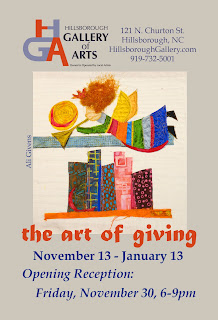a post by Pringle Teetor
This is a description of how some of the more complicated pieces in my current HGA show are made.

Making cane starts with picking up a piece of color bar that has been preheated to almost 1000 degrees on the end of a steel rod, then heated and shaped. This is the center color of the cane. While one person is doing this, another is preparing another chunk of color in the same way to cover the first color in an “overlay”. Then, by heating and shaping the glass on the marver, the second color is distributed to cover the first color, then one or two gathers of clear glass are added to encase the color. After the second gather, the glass is heated and shaped to set it up to be pulled into cane.

When pulling cane, one person prepares a 'post' on another steel rod to attach to the mass of colored glass. When the glass is at the right temperature, the post is connected to the end of the glass and the two people walk away from each other, stretching the glass like taffy. When the glass has been stretched to the diameter needed, the cane is held tight for a few seconds to ensure it's straight as it hardens. It is then set down on the wood boards to cool. Once cooled, the cane is cut into lengths to be incorporated into work.
Murrine (common pluralization murrini) is an Italian term for colored patterns or images made in a glass cane (long rods of glass) that are revealed when cut in cross-sections. Murrine
can be made in infinite designs—some styles are more familiar, such as millafiore To make the murrini, I make a color core in the same way as described above, then roll up cane around the core. The cane is heated on a plate in the glory hole by an assistant, then pulled the same way as cane.
Once cooled, the bars are sliced up on a diamond saw. In pieces where murrini is used for patterns, much of your time goes into planning and preparing to make the piece before you even start the actual piece.
INCALMO - is a technique invented in Murano in the 16th century, to create vessels with distinct bands of color. Two or more cylindrically-shaped blown objects of different colors are made then attached while hot on the blow pipe, and blown further to create a vessel. The joining of the two vessels takes great precision and careful measuring to ensure that the pieces will fit correctly and stay joined. Each piece of glass that is to be made into one is blown separately and must be the same width at the base or top where it is to be fused to another piece of glass. This second piece must be placed directly at the edge of the first piece and fit perfectly so there is no overlap with the edges.

Here is a picture of me working on a vessel when glass artist Ed Schmid was visiting from Washing State. The center part is a murrini roll up, which I previously attached to the vessel on the pipe, and now Ed is attaching the bottom vessel.
Murrini roll ups and incalmo pieces are something I would like to do more of in the future. However, these are not pieces I can do alone. Towards the end of this past season, I was fortunate to be able to hire an assistant, Matt Decker, who blows glass for Corning Museum of Glass, to work with me on the pieces in this show. These pieces take careful planning, extra time (and money) to produce, and my hope is to have more of this type of work in the future.















